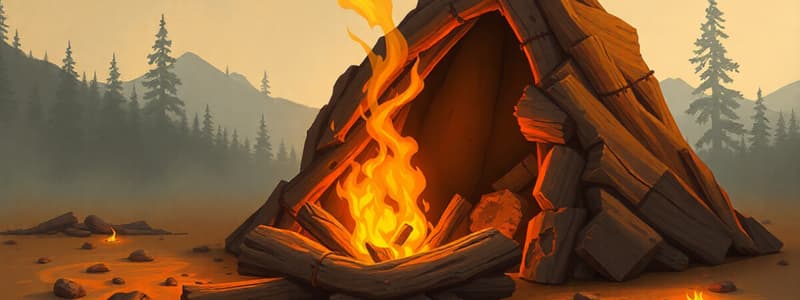Podcast
Questions and Answers
What is the first step in the usual sequence for lighting a fire?
What is the first step in the usual sequence for lighting a fire?
- Tinder
- Fuel
- Ignition source
- Spark (correct)
Which type of match should not be carried on an aircraft?
Which type of match should not be carried on an aircraft?
- Waterproof matches
- Safety matches
- Safety strike matches
- Strike Anywhere matches (correct)
What is a reliable method for creating a spark if flint is available?
What is a reliable method for creating a spark if flint is available?
- Using a cigarette lighter
- Scraping with a knife blade (correct)
- Employing pyrotechnics
- Using a battery
Why should a drop or two of gasoline be used with a tinder nest when lighting a fire?
Why should a drop or two of gasoline be used with a tinder nest when lighting a fire?
Under what condition can an electric arc be produced from the aircraft battery?
Under what condition can an electric arc be produced from the aircraft battery?
Which material is classified as a poor tinder choice due to its tendency to absorb moisture?
Which material is classified as a poor tinder choice due to its tendency to absorb moisture?
What is NOT considered a type of tinder for starting a fire?
What is NOT considered a type of tinder for starting a fire?
Which of the following options should you consider keeping dry for effective burning?
Which of the following options should you consider keeping dry for effective burning?
What type of tinder is best described as very flammable and light in texture?
What type of tinder is best described as very flammable and light in texture?
Which material would be least effective as tinder during damp conditions?
Which material would be least effective as tinder during damp conditions?
Which of the following is NOT a good option for kindling to start a fire?
Which of the following is NOT a good option for kindling to start a fire?
What should be avoided when selecting a site for building a fire?
What should be avoided when selecting a site for building a fire?
What is the purpose of kindling in fire lighting?
What is the purpose of kindling in fire lighting?
Which of the following conditions could hinder the burning of wood?
Which of the following conditions could hinder the burning of wood?
What is a common mistake made while lighting a fire?
What is a common mistake made while lighting a fire?
What should you do to ensure your matches remain useful while camping?
What should you do to ensure your matches remain useful while camping?
When starting a fire in wet conditions, which type of wood should be used?
When starting a fire in wet conditions, which type of wood should be used?
What is a suggested method to preserve matches from being wasted?
What is a suggested method to preserve matches from being wasted?
What is the benefit of splitting wood before starting the fire?
What is the benefit of splitting wood before starting the fire?
What should you do with tinder and fuel for the next day?
What should you do with tinder and fuel for the next day?
Flashcards
Fire starting methods
Fire starting methods
Different ways to ignite a fire, including matches, lighters, flint and steel, batteries, and pyrotechnics.
Safety matches
Safety matches
Matches for starting a fire, stored with a striking strip, and kept separate from aircraft.
Flint and steel
Flint and steel
A reliable fire-starting method using flint to create sparks that ignite tinder.
Tinder
Tinder
Signup and view all the flashcards
Pyrotechnics
Pyrotechnics
Signup and view all the flashcards
Tinder material
Tinder material
Signup and view all the flashcards
Cotton fuzz
Cotton fuzz
Signup and view all the flashcards
Dry tinder
Dry tinder
Signup and view all the flashcards
Tinder absorption
Tinder absorption
Signup and view all the flashcards
Fire starting materials
Fire starting materials
Signup and view all the flashcards
Essential fire fuel types
Essential fire fuel types
Signup and view all the flashcards
Fire safety layout
Fire safety layout
Signup and view all the flashcards
Ventilation for fire
Ventilation for fire
Signup and view all the flashcards
Fire lighting common mistakes
Fire lighting common mistakes
Signup and view all the flashcards
Ideal fire layout for trail
Ideal fire layout for trail
Signup and view all the flashcards
Reflector log principle
Reflector log principle
Signup and view all the flashcards
Dry matches
Dry matches
Signup and view all the flashcards
Fuel for next day
Fuel for next day
Signup and view all the flashcards
Wet forest fire starting
Wet forest fire starting
Signup and view all the flashcards
Feather sticks
Feather sticks
Signup and view all the flashcards




